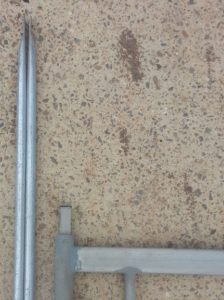Scaffold components must be regularly cleaned and inspected to ensure they are maintained in optimum condition and working order. Care of scaffold components will provide a safe and reliable scaffolding system.
All components should be regularly inspected and cleaned. In cases of severe deterioration, the components should be discarded. Superficial cleaning should be carried out by scraping, brushing or other abrasive methods which do not affect any surface treatment such as galvanising.Clean the threads on adjustable baseplates by wire brushing. Keep the scaffold as clean as possible but especially where sections are designed to join to each other (for example: adjustable baseplates, pinlocks and all pivoting connections).
Threaded parts require particular care when any treatment involving special cleaning processes or the deposit of protective coatings is applied, to ensure that threads retain their shape and size.


An example of dirty (left) and clean (right) scaffold components.
A scaffolder is very limited to the type of repairs they are authorised to carry out. All repairs must be performed by qualified persons who have received instructions specific to the equipment being repaired. Some points to consider in the repair of equipment include:
- Consult the manufacturer before attempting any repairs – there are many things that cannot be done to repair scaffolds.
- Only suitably qualified and competent persons should determine whether scaffolding components can be repaired or should be disposed of.
- Only qualified and approved persons should repair scaffold components.
- If there is any doubt about the soundness of component parts, the said component should be disposed of.
- Only genuine and approved manufacturer’s parts should be used to replace damaged or worn components.


Examples of broken/damaged scaffold components to be repaired.

